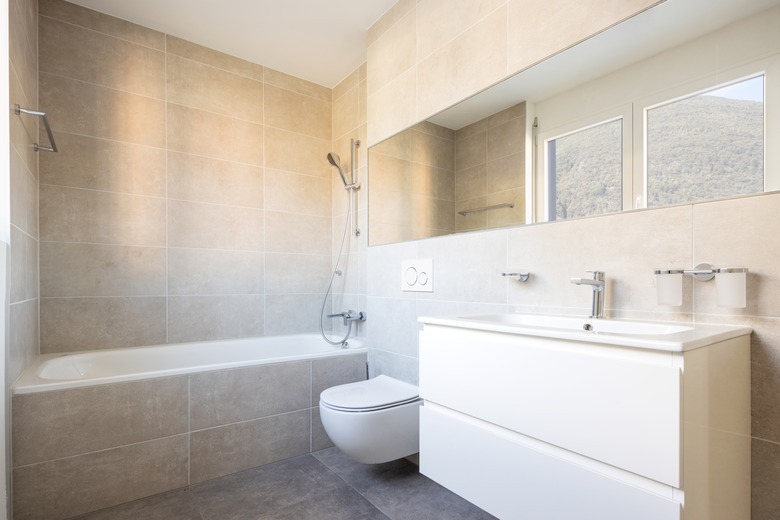Solutions For An 8-Inch Rough-In Clearance For A Toilet In A Basement
We may receive a commission on purchases made from links.
The term clearance usually refers to the distance from the toilet's sides and front to adjacent walls or the distance from the rear wall to the center of your toilet's closet flange. If your 8-inch rough-in clearance refers to the distance between the rear wall and the closet flange, you face an installation challenge.
Most toilet manufacturers produce units that require at least 10, 12 or 14 inches between the wall and flange. However, plumbers commonly encounter odd rough-in sizes, and there are several solutions to short drain clearances. Eight inches between the bowl and adjacent walls poses another problem. Codes require minimum clearances between fixtures and walls for accessibility and comfort.
Wall-Mounted Toilets
Wall-Mounted Toilets
If your existing toilet flange sits 8 inches from the wall, you can avoid using it altogether by installing a wall-mounted toilet. Whereas standard toilets drain through their bottom surfaces, wall-mounted toilet's drain through their rear side. Note that this solution would require you to plumb a new toilet waste line. Not all wall-mounted toilets hang from the wall. Some models sit flat on the ground like conventional toilets but have a rear side that butts flush against the wall to connect with a wall drain stub.
Offset Closet Flange
Offset Closet Flange
Offset toilet flanges are an accessory for existing toilet drains that sit too close to the basement wall. The exposed portion of an offset flange resembles a conventional flange's rim. However, whereas the conventional flange's shaft protrudes straight down from the floor's surface to connect to the main drain, the offset flange's shaft tilts at an acute angle before connecting to the main drain.
If you remove the conventional flange and replace it with an offset flange, you can usually move the toilet-to-flange connection roughly 2 inches forward; ideal for a 10-inch rough-in toilet. Note that making room for the offset flange probably requires you to chisel out some of your basement's floor.
Renovations to the Wall
Renovations to the Wall
Wall renovations allow you to increase the rough-in distance between the toilet's drain and the wall surface. If your current rough-in is 8 inches, you only need to move the wall back 2 inches to accommodate a 10-inch rough-in toilet. However, the only types of walls that you can move without professional assistance are non-load-bearing walls, also called partition walls. If you're unsure what type of wall abuts your toilet installation location, consult a professional for assistance.
Solutions for Insufficient Clearances
Solutions for Insufficient Clearances
Building codes specify clearances for the areas surrounding a toilet to ensure that you can safely and comfortably sit down on your toilet and retain use of all your limbs. If you're building an accessible bathroom, the clearances are even greater than they are for a standard bathroom.
Most codes require 15 to 18 inches of clearance at both sides of a toilet and at least 2 feet of clearance from the bowl's front tip to the nearest wall or plumbing fixture. While wall renovations are a common solution to meeting accessibility clearances, you can also meet clearance requirements with smart design. Rearranging sink and shower locations might spare the space you need to meet code.
